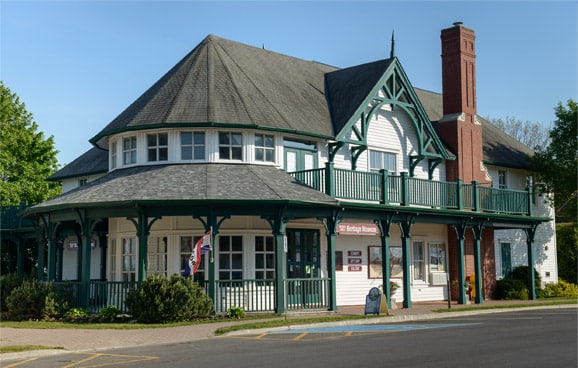
Looking for cultural and historical sites in the Frontenac arch Biosphere? You can find many major cultural and historical landmarks right here in the Frontenac Arch Biosphere area. These special places provide visitors with the opportunity to learn about the area’s rich history.
The Thousand Islands, which are part of the Biosphere and located in the St. Lawrence River in eastern Ontario and western New York, are a popular tourist destination. The islands are well-known for their scenic beauty, historic attractions, and recreational activities.
Here are ten cultural and historical sites in the Frontenac Arch Biosphere are you should visit:
The Thousand Islands National Park

The Thousand Islands National Park is located on a collection of tiny islands in the St. Lawrence River. It is well-known for its numerous plant and animal species, as well as its hiking and camping opportunities.
Alexandria Bay
Alexandria Bay, a small town on the St. Lawrence River, is known for its boating and water sports. It also has the Thousand Islands Bridge, which provides breathtaking views of the river and neighboring islands.
Clayton
Located on the St. Lawrence River, Clayton is a charming little town recognized for its lovely downtown area and Victorian-era buildings. It also houses the Antique Boat Museum, which exhibits vintage boats and maritime artifacts.
Boldt Castle
Boldt Castle is a historic castle on Heart Island in New York’s Thousand Islands region. George Boldt, the owner of the Waldorf Astoria Hotel, created it as a summer residence in the early 1900s. With magnificent towers, turrets, and balconies, the castle is a stunning example of Victorian-era architecture.
Construction of Boldt Castle began in 1900, but the unfortunate loss of Boldt’s wife in 1904 left it unfinished. For many years, the castle sat unfinished and abandoned until the Thousand Islands Bridge Authority purchased it in 1977 and began a restoration operation.
Today, Boldt Castle is a famous tourist site, providing visitors with the opportunity to see a fine example of Victorian-era architecture and learn about the castle’s history. The castle is open for tours to the public and holds a range of events throughout the year.
The Rock Island Lighthouse

The Rock Island Lighthouse on Rock Island in New York’s Thousand Islands region has a towering, conical tower and a keeper’s residence connected to the base. It is a truly stunning example of Gothic Revival architecture. In the early 1800s, they constructed the lighthouse to help ships navigate the tight passages of the St. Lawrence River.
In the early 1900s, they decommissioned the lighthouse and replaced it with a newer, automated light. They eventually restored the original Rock Island Lighthouse, and it is now open to the public for excursions. Visitors can learn about the lighthouse’s history and enjoy the breathtaking views of the surrounding area.
The Thousand Islands Museum

The Thousand Islands Museum occupies a former schoolhouse in New York’s Thousand Islands region. The museum displays artifacts, images, and papers from the Thousand Islands region’s history.
Founded in 1972 by a group of local citizens interested in preserving the history of the Thousand Islands region, it has now expanded to contain a collection of over 20,000 artifacts, including photographs, documents, and objects from the nineteenth and twentieth centuries.
The Thousand Islands Museum teaches visitors on the region’s history, including Indigenous history, early European settlements, and the establishment of the tourism sector. Throughout the year, the museum also conducts a range of events and educational programs, such as heritage craft workshops and talks on local history.
Fort Wellington
Fort Wellington is another one of the cultural and historical sites, this one located in Prescott, Ontario. Constructed in the early 1800s, it served as protection against potential American invasions during the War of 1812. The fort was named after the Duke of Wellington, a British military commander during the Napoleonic Wars.
Fort Wellington is a masonry fort with substantial walls and a central blockhouse that served as a barracks and a last line of defense in the event of an attack. A moat was also built around the fort to protect it from enemy forces.
Fort Wellington is now a famous tourist destination, providing visitors with the opportunity to learn about the area’s military history and witness an example of early 19th-century military architecture. Throughout the year, the fort is open to the public for visits and organizes a variety of events and educational programs.
Upper Canada Village
located near Morrisburg, Ontario, is a living history museum that recreates life in a 19th-century Ontario village. The museum houses a collection of approximately 40 old buildings that were relocated from various locations in Eastern Ontario and refurbished to create a small village with all staff in period costumes.
It has a blacksmith shop, a general store, a schoolhouse, a grist mill, and several houses. The museum also features a collection of agricultural animals from the nineteenth century, including horses, cows, pigs, and chickens.
Through interactive working exhibits, demonstrations, and guided tours, visitors to Upper Canada Community can learn and immerse themselves in the daily lives and work of residents in a 19th-century Ontario village.
You can even sign up to put on a period costume and take part in village life for a day! Throughout the year, the museum also conducts a range of events and educational programs, such as heritage craft classes and historical reenactments.
The Thousand Islands has so many exciting places to visit, and we’ve only touched on a few of them! There are also golf courses, vineyards, theatres, and restaurants, making it a wonderful trip for people of all interests.





